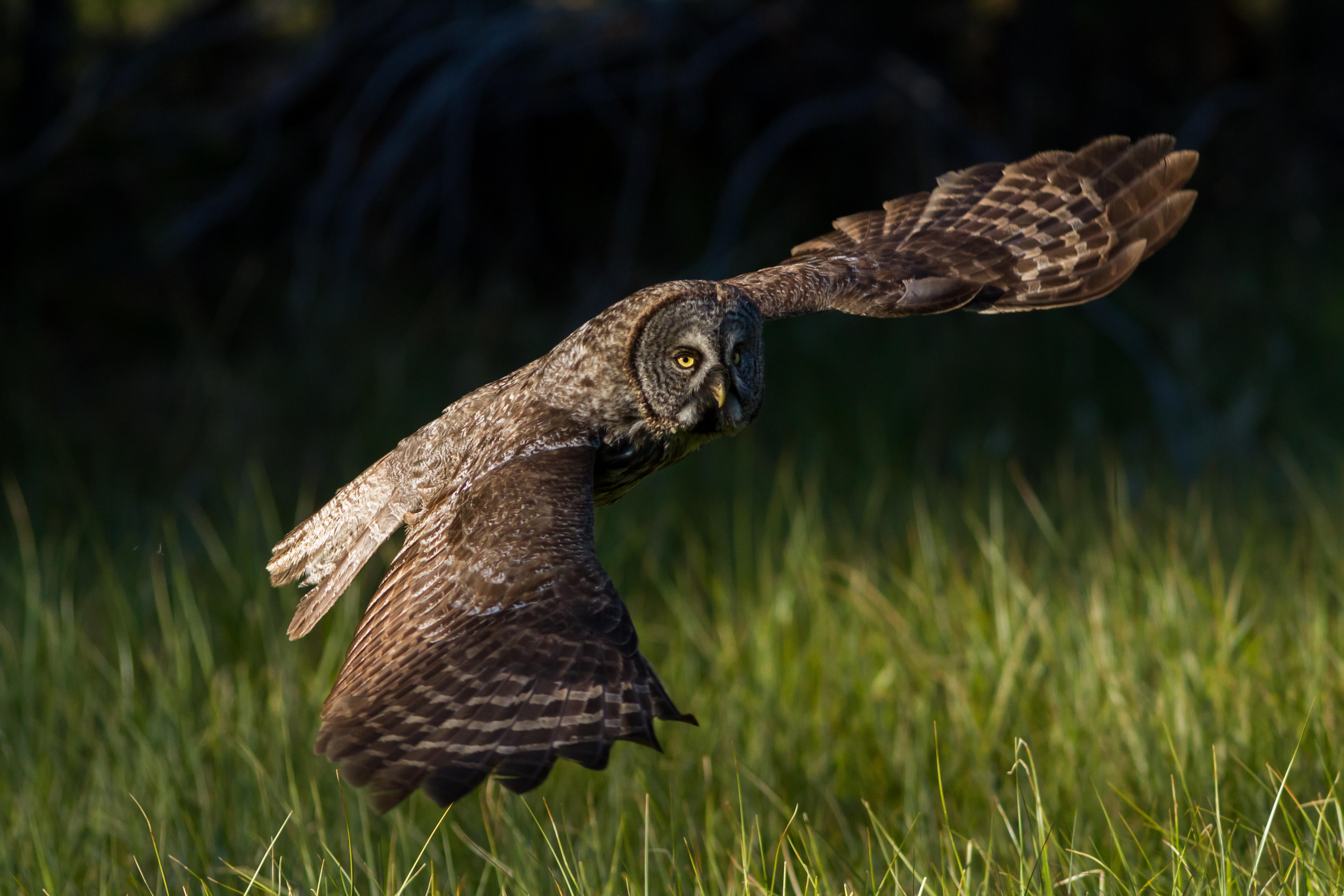It’s dawn. The rising sun is just starting to break through the boughs of ponderosa pine, gleaming on the frosty grass of a small forest meadow in Central Oregon.
Woodpeckers drill, “Rrrrrt-rrrrrt-rrrrrt.” Doves coo. But Ken Shults keeps his ears piqued for only one bird call: a low, “Whooooo-whooooo.”
He tips back his felt fedora, cupping his hand to shade his eyes as he squints.
He scans for any sign of motion against the dappled backdrop of boughs, pine needles, sunlight and shadow — a flitter of a feather, a slow twist of two intense yellow eyes.
Today he returns to a place he has been coming week after week, month after month, year after year.
Armed with tripod, camera and zoom lens, he is on a search to find one of the most elusive birds in America: the great grey owl.
Ghosts Of The Forest
“I think these birds are made of half magic and half mystery,” Shults says. “They can disappear into a forest like they were made of smoke.”
Great grey owls are so elusive that they’ve been nicknamed “the ghosts of the forest.”
Even their scientific name, strix nebulosa, speaks to this mysterious quality. Strix, the genus name, comes from ancient folklore. These were magical birds, sometimes associated with witches, and bearing ill omen. The species name nebulosa comes from the latin meaning misty, foggy or obscure. So in short: half magic, half mystery.
They’ve also been nicknamed the “phantoms of the north” because they live in the cold northern forests of Europe, Alaska and Canada. In the U.S., they may appear in the northern Rockies, Cascades and Sierras.
Although they are not federally listed as endangered, finding one is a rare occurrence.

The elusive Great Grey Owl.
Ken Shults
Great grey owls move silently through a forest and will quietly perch, rarely drawing attention to themselves. Cloaked in dappled feathers, they blend almost invisibly into trees. Unlike many birds, they usually won’t flush when someone walks by but will remain motionless.
Wildlife biologists have learned that owls are highly territorial and that if they play the call of an owl in their territory, most owls will hoot back. (This is how spotted owls, for example, are located). Great grey owls, however, will often ignore such calls.
After five years of searching, Shults has probably seen fewer than a dozen, he estimates.
He has discovered only one nest.
“It’s a big bird, but a much bigger forest,” he says, then heads to another meadow.
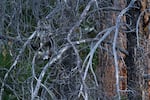
Great Grey Owls blend into the trees, and will often remain silent when people pass by or call to them.
Ken Shults
Everything That’s Not Tree
Finding great grey owls requires intense focus. “So part of the trick is to train your brain to not see the tree,” explains Shults. “You’re looking for everything that’s not tree.”
This intense focus on pattern and variation of pattern is not unlike his day job. Professionally, Shults is a web search optimization engineer for a tech company.
He’s the first to admit that when he gets into something, he really “goes deep.”
It’s been that way since he was a kid. In fact, when Shults was just 10 years old, he vowed one day he’d be in the Guinness Book of Records. He accomplished that goal in 1982 by kicking a hacky sack 13,901 times.
That feat took him two hours and wore out his tennis shoes.
Today, he’s circling this pocket of ponderosa pine forest for hours. He’s been up since 4 a.m. and now it's high noon. He’s been here many times before — in the thick of spring mosquitoes, in the sweltering heat of summer and in the snowy depths of winter.
“Last year I walked in four feet of snow in this forest, in snowshoes, for months,” he says. He estimates he spent some 200 hours searching for a nest and walked 100 miles. In other words, the young man who wore out a pair of tennis shoes kicking a hacky Sack now wears out his hiking boots on the trail of great grey owls.

Photographer Ken Shults searches for Great Grey Owls in the forests of Central Oregon.
Ian McCluskey / OPB
“How would you describe your personality,” I ask Shults. “Undeterred? Tenacious? Dedicated? Stubborn? Obsessed?”
Shults grins. Then chuckles. “All of the above.”
By returning to the same spots, he began to learn the habits of the owls. He could see the droppings by trees with branches just right for perching. He would notice signs of them on low stumps on the edge of grassy patches, where they could swoop onto mice.
Eventually, by learning how to think like a great grey, he began finding them.
“When you find one, every single time it’s just like …” He can’t find a word superlative enough. He simply gasps: “AHHHH!”
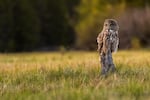
A great grey owl perches in a forest meadow, listening.
Ken Shults
Photographing The Great Greys
Shults could bring binoculars, like most bird watchers. But his camera gives his search a focus. If he finds an owl and photographs it, he’ll revisit the photo at home. Just seeing it brings back every sensation of his search, a memory trigger of the day, the moment of discovery.
Through his photography, he’s been able to watch the greys in the wild as few people have. In doing so, he’s learned a lot about these majestic owls.
The great grey owl is the tallest owl in North America, standing about 30 inches from head to tail tip. Its overall body appears larger than even the great horned owl. But this is just part of the great grey’s illusion. Its actually weighs less than a great horned owl, a mere 2.5 pounds, and the rest of its body mass is just a thick layer of feathers.
With such a light body and a five-foot wingspan, it can easily glide at slow speeds, nearly hovering, before plunging onto its prey.
Shults has watched them hunt for hours. In snow. Shivering behind his 200mm lens. He marvels at how the owls can hear a mouse across a meadow, even one below a foot of snow.
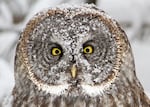
The rings of feathers around the owl's eyes scoop in sound like radar dishes.
Ken Shults
One reason their hearing is so perfect is how their feathers lay around their large yellow eyes. These feathers form two large concave audio receivers, similar to radar dishes, to scoop up sound from far distances.
In addition, their ears aren’t symmetrical. Rather, one is lower, allowing sound waves to arrive at slightly different times. In this way, the owl can triangulate the precise location of the sound.
When watching the owls, Shults keeps his distance.
“I don’t want to watch them reacting to me,” he says. “What I’m trying to do is like capture the scene. Like what was going on? What’s the story? What is it like to be this owl?”

A Great Grey Owl swoops in to catch its prey.
Ken Shults
Recently, he's teamed up with a master of a 19th-century printing technique, to create beautiful handmade platinum prints. The images are stunning, subtle shades of sepia, almost like watercolor, haunting just like the owls' reputation as "ghosts of the forest."
But Shults’s motivation isn’t commercial. His drive comes from the love of the challenge, the wonder and the beauty of a successful photo.
"Aren't you just taking pictures of the same owl," one of his friends teased him. "Not just the same type of owl, but literally the same owl."
Shults concurs. Over the past five years, he’s taken some 20,000 photos of great greys, and in those are maybe, he guesses, just a dozen different owls. So yes: he keeps taking photos of the same owls. Over. And over. And over.
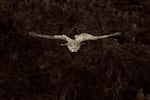
Ken Shults is taking his images of owls into the realm of fine art prints.
Ken Shults
Quest For The Nest
Shults has been circling the woods since sunrise and now it’s getting late. He has spotted only one owl. But he still hasn’t found any signs of a nest.
He scans each nook and hollow of the trees.
Great greys, like other owls, don’t build nests. They may move into the abandoned nests of other birds or hunker into a broken treetop.
Finding a nest is the only way to witness the owls rearing their young. And it’s a chance to photograph what few people have ever seen.
In all his years of searching, Shults has found only one nest.
It took him eight attempts and he spent about 20 hours in the search.
“I now realize finding that first nest was like finding it immediately,” he says.
It’s been three years since then.
It's dusk now and Shults is about to lose light for shooting. And it’s looking like he’s going to have to accept another day searching in vain. But then something in the treetop catches his attention.
He deftly sprints through the forest, stepping over downed branches, weaving between saplings, to get a better look. Then he grins and points.
Some 50 feet up in a tangle of branches wedged in a crook of a bough, sits a female.
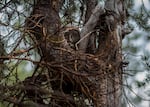
A Great Grey Owl on her nest, high in a tree.
Ken Shults
She calls out and a male, in a nearby tree, calls back. To the average onlooker, like me, it’s not clear what’s happening. But Shults knows.
The male has returned from hunting in the field. He’s perched a few dozen yards away with a mouse dangling from his beak. He waits for the female to signal that the coast is clear, so he can safely and secretly deliver the meal.
Shults is shaking. He’s trying to catch his breath — not from the short sprint but from sheer elation. He rests his hands on his thighs, nearly doubled over. Then he looks up, as if he doesn’t know if he’ll laugh or cry.
“She’s in the nest!” he stammers. “Finally!”
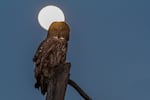
A Grey Owl and a full moon, captured by Ken Shults.
Ken Shults
Keeping Their Secret
Now that he’s found a nesting pair, he’ll return throughout the summer to watch the babies grow up and take their first flight.
“Now I have this obligation,” he says. “I know where these guys live. They’re very sensitive; there’s very few of them. There’s a responsibility to protect them.”
Shults will continue to share his love of great greys through his photography, but he’ll keep their location secret.
The moon is up, full and bright. Shults takes one last picture, slings his camera and turns back for home — leaving the “ghosts of the forest” to reclaim the night.

Nicknamed "the Ghost of the Forest."
Ken Shults
